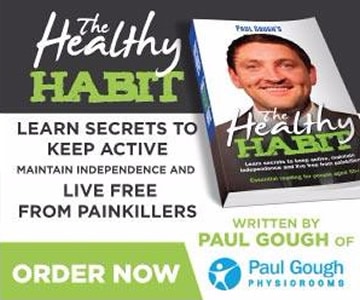
Sciatica is something that many of our patients at Paul Gough Physio Rooms suffer with, but how do you know when your sciatica/sciatic pain is improving?
For lots of people, sciatic pain can be some of the worst pain they’ve ever felt.
When sciatica is at its worst, relief can seem unlikely and nothing will seem to help…
So the idea of your sciatic pain getting better is a huge relief for those that struggle with it.
What Is Sciatica?
Sciatica happens when something presses or rubs on the sciatic nerve.
Sciatica is a type of pain caused by an irritated nerve and the pain is often felt from your bottom right down to your feet (and sometimes even your toes!).
What Causes Sciatica?
Sciatica is most commonly caused by a slipped disc, which puts pressure on the sciatic nerve, and then causes the pain you’re feeling.
However, certain behaviours/factors can raise your risk of developing sciatica. The most common factors for developing sciatica include the following:
- As your body ages, it becomes more and more likely that parts of it will wear out or break down.
- Certain careers place a lot of strain on your back, especially those that involve lifting heaving objects, sitting for extended periods of time, or twisting movements.
- Having bad posture.
Do you want to improve your posture? Learn how to improve posture for a healthy back to find out how you can do this from your seat!
How Can I Ease My Sciatic Pain?
The problem is that if you completely rest when you’re in pain, not only does the disc stay slipped but the muscles that control your lower back will become weak, and therefore provide less support to the already problematic and painful area.
Limiting the amount of time that you spend sitting can help too. I know what you’re going to say… ‘sitting doesn’t make it worse’, but we find that many clients are sitting in a modified or slouched way to avoid their pain.
This makes your pain last longer and often leaves you with an uncomfortable-looking posture long after the back trouble has gone.
Don’t Stop Walking
Continue gentle exercise as soon as you can – anything that gets you moving can help.
Gentle walking can work wonders for those suffering from sciatica because regular walking spurs the release of pain-fighting endorphins and reduces inflammation.
Walking is one of the most overlooked forms of exercise, it’s simple, free, and one of the best ways to get more active, become healthier, and lose weight without too much effort.
Alternate Heat And Ice Therapy
By using both heat and ice therapy, this can provide relief for sciatica. Ice helps with inflammation and heat encourages blood flow, but of which are essential to easing painful muscle spasms.
Stretch It Out!
Every day that you wake up and you’re not doing something small to help yourself to stay active, you’ll be getting more and more stiff.
You’ll be losing flexibility of vital muscles and joints, and as this happens, you’re more and more likely to suffer from things like sciatica and other life-changing pains.
We’ve added a video of our therapist, Elle, in which she talks about her top tips to relieve back pain!
How Do I Know When My Sciatica Is Improving?
Determining if sciatica is getting better is actually pretty straightforward.
The severity of the pain isn’t a good indication of healing, but the actual location and movement of the pain is.
It’s as simple as knowing whether the pain is ‘retreating or going’ or whether the pain is getting more intense.
Think about it, if the pain is in your bum one day and down your legs the next, the pain has more than likely got worse and it’s not improving. And if the pain is ‘leaving’, then the sciatica is improving.
For most people, sciatic pain usually lasts between 2-6 weeks with acute pain lasting around 1-2 weeks.
Does Sciatica Get Worse Before it Gets Better?
Sciatica can get worse before it gets better – but it can get better.
Specific exercises (and of course, physiotherapy) can help. It might be painful at first but if you persist with exercises and treatment, the pain level can begin to drop.
CLICK HERE to read about how we helped a NHS nurse with her Sciatica!
Would You Like To See A Physio For Free?
We realise some people want more than just some free health tips… That’s why we offer expert advice about the worry and frustration of life-changing aches and pains – for FREE, in under 30 minutes.
Here are just a few of the things you will learn in one of our free taster sessions:
- What is the underlying cause of your back pain? (hopefully nothing too serious!)
- Roughly, how long will it take to fix my problem?
- What to do to help – which doesn’t include painkillers, resting or surgery etc.
- What other, natural, drug-free methods are there to speed up recovery alongside treatment?
Our taster sessions are great for anyone that may be “unsure” if physio is right for them, and they give you the opportunity to ask questions and see for yourself if we can help you.
We’ve got 5 taster sessions available this week. If you would like one of our limited taster sessions, please get in touch with the clinic using the contact details included below, and mention to the person who answers the phone that you would like to see a physio for free.
We’re Here To Help…
If you’re in pain and would like to talk to us about getting some help, some specialist advice, or if you are looking for a diagnosis, remember we are always here to help you…. and we’re offering you the chance to have your first session with a physio for FREE (with a taster session).
If you would like to get one of our limited taster session slots, please complete our enquiry form or CALL us on 01429 866771.
For more expert advice, read our other blogs or check out our YouTube channel:
Read Our Blog – How to Fix Sciatica and Finally Overcome the Agonising Pain
Read Our Blog – Why Does My Sciatica Cause Pain Down the Back of My Leg?
Read Our Blog – Back Pain: The Real Problem With Sciatica And What To Do About It
Visit Our Paul Gough Physio Rooms YouTube Channel

